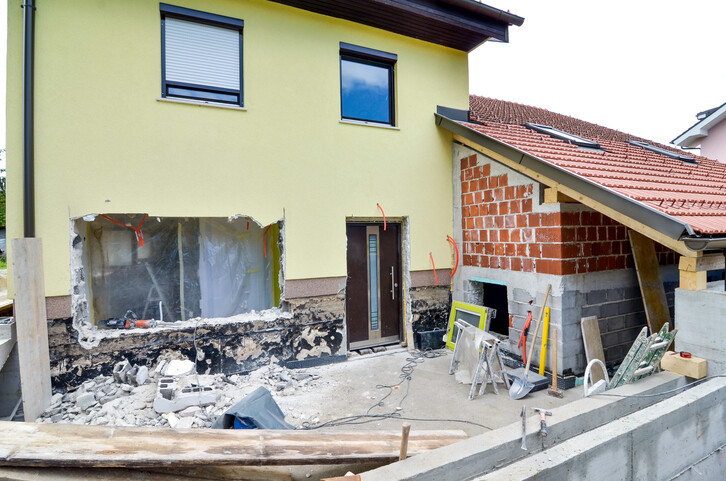 Whether you are looking to extend your dining space, make space for a home office or even create new rooms, an extension is the solution. Building an extension can greatly increase the value of your home in addition to giving you additional living space to enjoy.
Whether you are looking to extend your dining space, make space for a home office or even create new rooms, an extension is the solution. Building an extension can greatly increase the value of your home in addition to giving you additional living space to enjoy.
There are several key steps to building an extension, one of the most important aspects of this process is constructing the shell, which forms the structural foundation of your extension. In this blog, we'll walk you through the key steps involved in building the shell of a home extension and the essential tools and equipment you'll need to get the job done safely and efficiently.
Section 1: Planning and Preparation
It is essential that careful planning and preparation is in place before any work begins. Begin by assessing your site, take note of any unique features that may impact your build, such as soil type, slope and access points. When working on your design plan, be sure that everything is up to standard with local and national authorities. House extensions should always meet the relevant planning permissions dictated by the local council. Once you have an approved plan in place, it’s time to prepare your building site. This involves clearing any obstacles, marking out the area where the extension will be built and making sure there’s adequate access for the machinery and tools.
Section 2: Digging and Preparing Foundations
Once your site has been prepared, work can begin in digging the foundations.
Recommended Tools & Equipment:
- Mini excavators and diggers: For digging trenches to the required depth and dimensions.
- Dumpers: For moving excess soil and debris around or off-site.
- Excavator attachments: Such as buckets and augers to handle various ground conditions.
Precision and safety must be the priority during the excavation process, ensure that all of your equipment is up to specification and every worker has the necessary PPE.
The trenches need to be the correct size and depth to ensure a solid foundation for your extension. After digging, the ground must be levelled and compacted to provide a stable base for the foundations.
Section 3: Laying the Foundations
 Laying the foundations is one of the most critical stages in building your extension.
Laying the foundations is one of the most critical stages in building your extension.
Recommended Tools & Equipment:
- Concrete mixers: To create a uniform concrete mix.
- Compactors and vibrators: For ensuring a solid and even foundation.
- Tamping equipment: To level out wet concrete.
There are different types of foundations, such as slab, strip, and trench foundations, each suitable for different types of builds. Choosing the right type for your project is essential for the stability and longevity of the extension. Once the concrete is poured, it must cure and set correctly, as rushing this process can lead to weaknesses in the structure.
Section 4: Building the Walls and Structural Frame
It is essential that your structural frame is well built, as it will provide the bones to support the remainder of the project.
Recommended Tools & Equipment:
- Scaffolding: Essential for safe access when working at height.
- Hoists: For lifting heavy materials such as blocks or timber beams.
- Bricklaying and blockwork tools: For building external walls.
Taking the time to check and double-check your work as you build the walls can save you from costly and time-consuming corrections later on. Even a slight tilt in a wall can cause issues when installing doors and windows, leading to drafts, leaks or difficulty in opening and closing them. Furthermore, uneven walls can cause problems when fitting cabinets, shelves, or other built-in furniture, as well as complicate the installation of flooring and ceiling materials.
Section 5: Constructing the Roof
Whether you choose a pitched roof or a flat roof will depend on the design of your extension and your personal preferences. Each type of roof has its benefits.
Pitched roofs offer the bonus of helping with water drainage whilst offering a classic appearance. On the other hand, flat roofs compliment a modern style and are often more cost effective. Regardless of the style, it's crucial to ensure the roof is structurally sound and well constructed to protect your home from the elements.
Recommended Tools & Equipment:
- Scaffolding and access towers: For accurate roof installation.
- Roof hoists: For lifting trusses or roofing materials.
- General construction tools: For timber cutting, nailing and securing roof components.
Proper insulation is another critical aspect of roof construction. A well-insulated roof helps maintain a comfortable temperature inside your extension, reducing the need for excessive heating in the winter and cooling in the summer.
Section 6: Additional Building Equipment
Throughout the shell construction phase, you'll likely need a range of additional tools and equipment. These might include cutting and grinding tools, cement mixers and wheelbarrows for transporting materials, as well as ladders and safety gear to keep your team secure on-site. Having the right equipment on hand not only makes the job easier but also ensures that the work is completed to a high standard.
Looking for Equipment for Your Home Extension Project?
Speak to Drogheda Hire and Sales.
Constructing the shell of a home extension is a complex task that requires careful planning, the right tools and a focus on safety. Make sure you are hiring tools and equipment from a reliable company. At Drogheda Hire and Sales, we are proud to provide only the best service for our customers. Call us on 0419841419 for our Drogheda depot or on 01 9108757 for our Dublin depot, use our contact form or try our Enquiry Bot at the bottom left hand corner of our home page.
